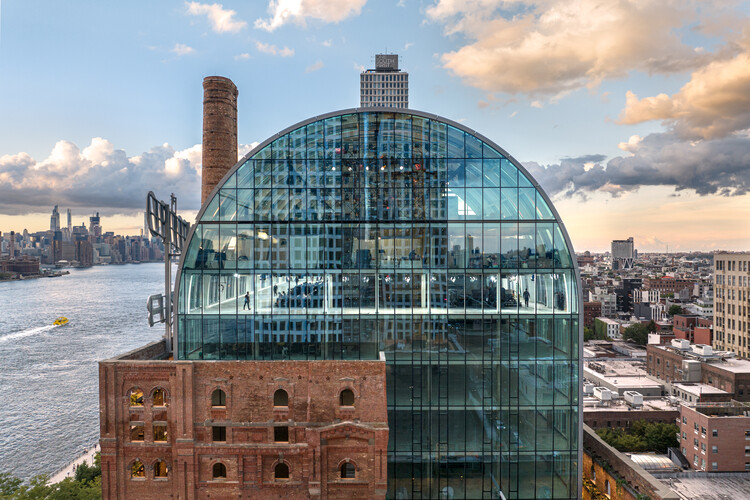
Two Trees Management announced the official reopening of The Refinery at Domino Sugar, one of Brooklyn’s most iconic buildings transformed into a modern workspace. The design of the adaptive reuse project, led by Practice for Architecture and Urbanism (PAU) began in 2017 with the purpose of reimagining the monument to become a point of connection between the existing neighborhood and the recaptured waterfront. The building now features 15 stories of office space, approximately 460,000 square feet, complete with retail spaces, communal workspaces, a private club, and event spaces.

As part of the strategy for the renovation process, PAU nestled a new glass building into the existing brick façade, maintaining a 12-foot gap between the two structures. This allows for standardized floor heights while ensuring appropriate light levels and access to outdoor spaces for all future users. The 12-foot space between the glass curtain wall and the masonry exterior is populated with a large-scale ecosystem with native plants, demonstrating a model for biophilic office design. The vertical garden was designed by landscape architecture firm Field Operations, while the interiors of the building were created by interior designer Bonetti/Kozerski and Executive Architect dencityworks.


The adaptive reuse project integrates parts of the historical buildings, including the old Havemeyer building’s 214-foot tall chimney. The sugar manufacturing machinery house inside the building has been repurposed and placed throughout Domino Park as historical relics. An energy-efficient LED replica of the iconic “Domino Sugar” neon sign has also been included to hint at the original image of the factory. The project also aimed to become one of New York’s most environmentally responsible buildings. It features all-electric equipment and a private water reuse system that diverts polluted water from city outfalls, thus reducing stress on the city’s infrastructure.
Related Article
PAU’s Vishaan Chakrabarti on How Progressives Ruin Cities in Uncertain Things PodcastThe transformation of The Refinery entailed three major design moves—inserting a contemporary building in the sleeve of the historic structure similar to the machinery it once housed, creating a glass barrel vault form that pays homage to the American Round Arch style of the original, and opening the ground floor to the park and the surrounding Williamsburg neighborhood. This approach has created an iconic landmark for the 21st century, offering users natural light, luscious greenery, waterfront views, and a contemporary dialogue with history that most new commercial projects lack. - Vishaan Chakrabarti, Founder and Creative Director of PAU


Built in 1884, the Domino Sugar Refinery was once the largest sugar manufacturing producer in the world. It was closed in 2004 after 12 years in operation, prompting New York Landmarks Preservation Commission to name he Filter, Pan, and Finishing House of the Refinery a landmark site in 2007. Since then, a long reconversion process begun, which included the 11-acre Domino Park master plan in Williamsburg, Brooklyn, and the reimagined Domino Sugar Refinery building designed by PAU. In a recent interview, PAU’s Vishaan Chakrabarti discusses the renovation plans drawing parallels to pressing issues of urban environments.


























